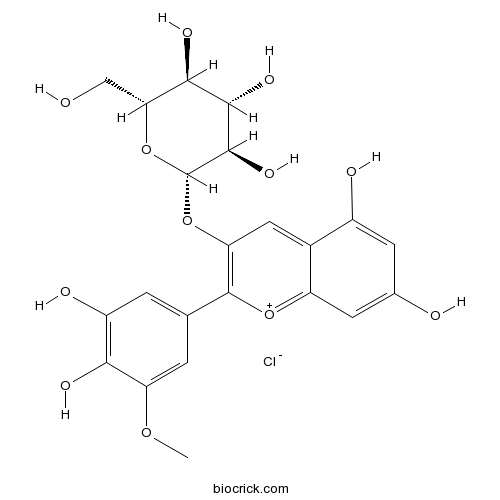An anthocyanin cation that is petunidin substituted at position 3 by a β-D-glucosyl residue
InChI=1S/C22H22O12.ClH/c1-31-14-3-8(2-12(26)17(14)27)21-15(6-10-11(25)4-9(24)5-13(10)32-21)33-22-20(30)19(29)18(28)16(7-23)34-22;/h2-6,16,18-20,22-23,28-30H,7H2,1H3,(H3-,24,25,26,27);1H/t16-,18-,19+,20-,22-;/m1./s1
Peonidin-3- O -glucoside chloride,delphinidin-3- O -glucoside chloride, cyanidin-3- O -glucoside chloride present in Vitis vinifera L, all hydroxyl groups of the anthocyanins can be electrochemically oxidized and the anthocyanins studied revealed a complex and pH dependent oxidation process, with the occurrence of adsorption and of oxidation products blocking the electrode surface.[1]
Petunidin-3-O-glucoside shows strong antioxidant activities, including DPPH radical-scavenging capacity, ABTS radical scavenging capacity, reducing power and oxygen radical absorbance capacity (ORAC). [2]
English website: Petunidin-3-O-glucoside chloride
Japanese website: Petunidin-3-O-glucoside chloride
Chinese website: Petunidin-3-O-glucoside chloride
[1] Poskuta J. Electroanalysis, 2007, 19(17):1779–86.
[2] Cui C, Zhang S, You L, et al. Food Chemistry, 2013, 139(1-4):1-8.
[3] You H, Ouyang J, Yan-Wen W U, et al. Journal of Instrumental Analysis, 2010, 3.



